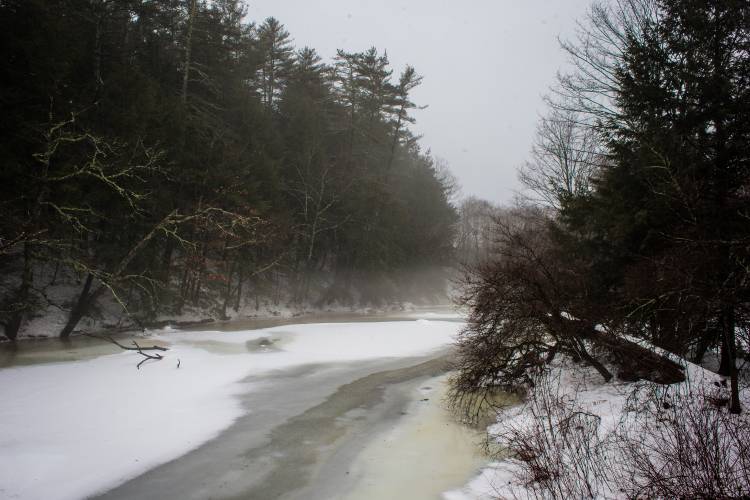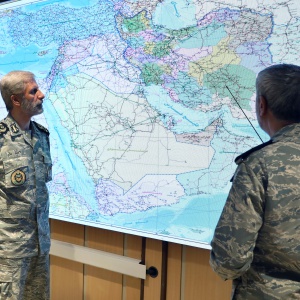Opinion: The fate of a river in Warner

Fog lingers over the Warner River near the Dalton Bridge in Warner. Monitor file
| Published: 03-09-2024 7:00 AM |
Artist, naturalist, and writer David M. Carroll lives in Warner.
As it has long come to be for any places with wildness, natural wildness with rich and complex ecosystems and biological diversity, the fate of the Warner River and its ecologically and esthetically exemplary riverine and riparian corridor, rests in human hands.
This is, of course, the global operative, with places of true natural landscape integrity and respect essentially remaining in the keeping of indigenous peoples. And these people and their holdings are themselves under unceasing pressures for exploitation, development, and vast transformation to serve recreation.
In very short order, the rail trail would undue the millennium of evolutionary workings that began as the last glacier retreated, to co-evolution that has resulted in the river we know today. A balance of complexity beyond human comprehension becomes unbalanced by such manipulations.
Over that ten thousand years the original people, now displaced, replaced, did not take one thread of running water, from the enormous and intricate tapestry of Earth’s global ecosystem.
The riverine, wetland, and upland habitat mosaic of the Warner — yet largely in its natural state — currently serves exemplary ecosystems and their abundant native flora and fauna, an increasingly diminished, to rare, biological diversity.
It is of great note that the river, its floodplains, vernal pools and other wetland niches protect and provide — cover, food, raising young — for all species, which is especially critical for those in decline, and a number of them threatened with extirpation and even extinction throughout their beleaguered natural ranges. The migratory function of the corridor must not be overlooked, or driven from existence. The river and its corridor are themselves, in their current largely untrammeled status, endangered species.
With the implementation of the severely invasive, habitat-consuming, rail trail project all of these biological requisites would become subject to heavy negative impacts, severe disturbance. The reality of what mere human presence and activity bring to bear, exacerbated by the ubiquitous accompaniment of dogs, must come to be recognized. One of the most damaging outcomes for wildlife involves flight response, taking to cover, an obligate evolutionary reaction that is activated by these combined disruptive interferences, impacting, among other things, foraging, courtship and mating, raising young.
Article continues after...
Yesterday's Most Read Articles
 Update: Founder of neo-Nazi group spotted among masked protesters in Concord
Update: Founder of neo-Nazi group spotted among masked protesters in Concord
 Car strikes pedestrian in fatal collision on Loudon Road
Car strikes pedestrian in fatal collision on Loudon Road
 Concord Police investigating altercation involving neo-Nazi group; local officials and organizers condemn the Blood Tribe
Concord Police investigating altercation involving neo-Nazi group; local officials and organizers condemn the Blood Tribe
 NH Supreme Court rules Concord resident lacks standing, clearing way for Andy Sanborn’s casino plans on Loudon Road
NH Supreme Court rules Concord resident lacks standing, clearing way for Andy Sanborn’s casino plans on Loudon Road
 Work continues deconstructing Burlington store at Capitol Shopping Center into four retail spaces
Work continues deconstructing Burlington store at Capitol Shopping Center into four retail spaces
 Update: Three individuals seriously injured in Hopkinton rollover crash on I-89
Update: Three individuals seriously injured in Hopkinton rollover crash on I-89
Silence, solitude, space, and time, along with connectivity, are sine qua nones of the life of natural communities. The tweaks that come from environmental consultants and reviews, engineering, cannot avoid an unsustainable taking-away of these fundamental ecological requisites, which should be the inalienable rights of nature.
That the intense incessant level of these and other impacts (including habitat loss, marginalization, fragmentation, and alteration) are unavoidable in all that comes with the running of a rail trail, any trail, through a natural realm should be obvious. A degree in biology or environmental science is not a requirement for this level of awareness.
It must also be recognized that the rail trail agenda is but the tip of an iceberg, in terms of the avowed vision expounded by Tim Blagden and associates of turning the Warner and Contoocook Rivers into a tourist destination for people from Boston (and elsewhere, I have to imagine); with other not so well known plans. I believe the one for a game park and boat launch at the riverside parcel once unwisely considered for a fire station has been abandoned.
I don’t think the exploration of having water from Lakes Todd and Massasecum being released to raise the water level of the Warner River one foot has gained any traction. Discussion of a mountain bike trail up the other side of Mount Kearsarge has been opened.
Before we can begin to properly address the alarming acceleration of extinctions, endangered species realities, we must confront the endangering species. And when we seek to combat the quite possibly irreversible, profoundly species-eliminating effects of invasive species, we must take a look in the mirror.
It is hard to know how to put it. I hear of the river being as being “our” river. By what authority, and by what means has ownership been so confirmed? It is, I could think, a neighbor adjacent the Warner Community, so proudly spoken of. The river is a community, a natural community made up of communities, with its own rights, the rights of nature that we are inexcusably and damagingly remiss in not recognizing.
How would joining the natural-world-diminishing, consuming, rail and other trail mania (conservation commissions have wholeheartedly signed on to trail-building in their mission to “protect and utilize”) portray the character of our town, with its pronounced dedication to keeping its “rural” character, and, I think to a degree, a wildness in nature?
We’d be profoundly praised in partisan circles for joining trail expansions. And we might well be vilified for standing against this usurpation of nature. But I do believe that we would be deeply admired, and thanked, for putting a river first.
Forthcoming elections, and town meeting, offer opportunities to speak for the river, and endeavor to bring about a denial of the construction of a rail trail through the Warner River’s natural-environment corridor. Overlooking the “earth cost,” the bankrupting of a river for recreational pleasures and dubious at best underlying economic considerations, is unacceptable. We must not walk away from the fate of the river.







 Opinion: My client Ozzy Osbourne
Opinion: My client Ozzy Osbourne Opinion: Trumpism in a dying democracy
Opinion: Trumpism in a dying democracy Opinion: What Coolidge’s century-old decision can teach us today
Opinion: What Coolidge’s century-old decision can teach us today Opinion: The art of diplomacy
Opinion: The art of diplomacy
